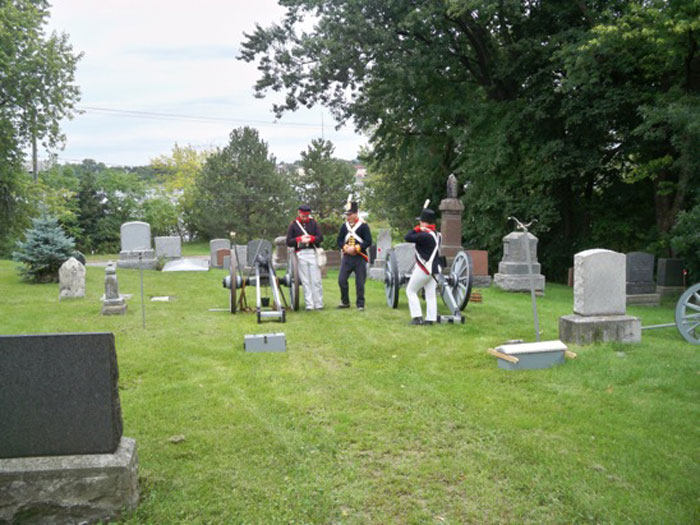Kerby was a militia officer, businessman, Justice of the Peace, office holder, and politician; b 1785 at Park Farm near Sandwich (Windsor, Ont.), son of John Kerby and Alison Donaldson; m 1811 Jane Lambert, and they had three children; d 20 June 1854 at Fort Erie, Upper Canada.
In 1805 Kerby began working at Queenston as a clerk-bookkeeper for Thomas Clark who not only ran a series of profitable businesses but was also a senior officer in the militia. When Clark became commanding officer of the 2nd Regiment Lincoln Militia on 9 July 1809, Kerby was appointed regimental adjutant. The outbreak of hostilities with the United States in the summer of 1812 disrupted trade along the frontier and ended the business activities of Grant and Kerby. Both men were immediately involved in militia affairs.
Kerby remained adjutant of the 2nd Lincoln and also commanded an Artillery Company in support of it. On the morning of 9 Oct 1812 his company was manning the British batteries on the Niagara River opposite Black Rock (Buffalo, NY) when it was ordered to open fire on the Detroit and the Caledonia, ships which had been captured by an American raiding party. In this, his first action under fire, Kerby seems to have performed well. After the death of Sir Isaac Brock at Queenston Heights, the Americans mounted another offensive on 28 November. The attack was countered and, for his part in the action, Kerby received his first official commendation for service under battle conditions. Following the abortive offensive, the British continued to fire at troop movements on the opposite shore and during one such fire fight, on 2 Dec 1812, a twenty-four pound cannon burst and Kerby was wounded severely in the right hand.
When winter ended a campaigning season, the militia usually returned to their homes, but the seriousness of the situation early in 1813 prompted the organization of the Volunteer Incorporated Militia Battalion, essentially a full-time organization composed of volunteers, which Kerby immediately joined on 25 March as a Captain. In late May 1813 the Americans attacked and occupied Fort George (Niagara-on-the-Lake) and subsequently occupied the entire Canadian side of the river. Kerby accompanied the British forces as they withdrew before the Americans, and throughout the summer and autumn he commanded a small group of volunteers who joined the advance guard of Major-General John Vincent’s division. By the end of the year, however, the British had reoccupied the frontier and in December captured Fort Niagara (near Youngstown) on the American side of the river. In this action, Kerby directed the embarkation of troops for the assault and was the first person to land on the American side. His activity in one of the storming parties was recognized in official dispatches and subsequently by the assembly which on 14 March 1814 voted that a sword, value fifty guineas be presented to Captain Kerby.
At the beginning of July 1814 an invading force of Americans crossed the Niagara River at Fort Erie and moved towards Queenston. Kerby’s battalion was hurriedly moved to the area and participated in the Battle of Lundy’s Lane which followed. Kerby had just been promoted major and, when his commanding officer, Lieutenant-Colonel William Robinson, was wounded, he assumed command of the battalion. It suffered 142 casualties but Kerby’s handling of the force was commended by Lieutenant-General Gordon Drummond. Kerby remained in command of the battalion during the Siege of Fort Erie where he was wounded in both the shoulder and the hip, and was again singled out for honourable mention in dispatches. Disabled for several weeks, he resumed acting command of the Incorporated Militia on returning to duty. The battalion saw no more fighting, and the peace arranged in February meant that the incorporated militia could be disbanded. After two years of continuous military service, Kerby could attempt to resume his civilian career.
After the War of 1812, Kerby continued his civilian career. In the 1830s Kerby was frequently bothered by ill health, which apparently interfered both with the profitable operation of his mill and with his service on the Legislative Council, to which he was appointed in 1831. On 20 Dec 1837, shortly after the unsuccessful insurrection led by William Lyon Mackenzie, Kerby was authorized to raise a special force from militiamen to resist any invasion Mackenzie might mount from American territory. Under Kerby’s command this force became known as the Queen’s Niagara Fencibles and served actively for a year and a half. From 5 April to 2 June 1838 Kerby was in command of all troops on the Niagara frontier, and throughout the summer and following winter he continued to play an important role in the courts martial and pacification which followed Mackenzie’s rebellion.
In his later years Kerby seems to have been hard pressed for funds. In 1843 he sold his mill, though he retained his positions as postmaster and collector of customs. Illness continued to be a difficulty: he was frequently sick and in 1839 both his wife and his mother died; in 1846 his son died at 24 and the death of a son-in-law meant that one of Kerby’s daughters and her small child became dependent on him. None the less, he remained active in the militia. With the reorganization resulting from the Militia Act of 1846 came the formation of the Welland Regiment. Kerby became commanding officer of the 1st Battalion and remained the senior militia officer in the Niagara District. He was a member of the committee formed to superintend construction of a new memorial to Sir Isaac Brock, designed by William Thomas. When the memorial cornerstone was laid, he acted as one of the honorary pallbearers for Brock’s coffin. Kerby died on 20 June 1854, allegedly of cholera brought on by eating greens. He was buried at Fort Erie in St Paul’s where a memorial window and tombstone commemorate him.
This biography has been taken directly from the Dictionary of Canadian Biographies.

